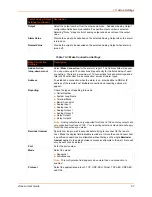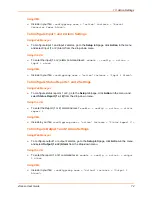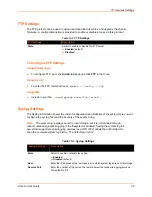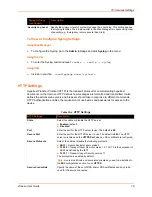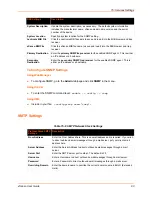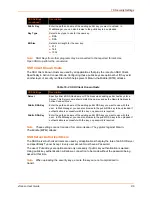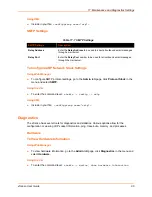
15: Services Settings
xSenso User Guide
81
Table 15-5
HTTP Authentication Settings
To Configure HTTP Authentication
Using Web Manager
To configure HTTP Authentication, o to the
Admin
tab/page,
click
HTTP
in the menu and
select
Authentication
.
Using the CLI
To enter the HTTP command level:
enable -> config -> http
Using XML
Include in your file:
<configgroup name=”http authentication uri”
instance=”
uri name
”>
RSS Settings
Really Simple Syndication (RSS) (sometimes referred to as Rich Site Summary) is a method of
feeding online content to Web users. Instead of actively searching for configuration changes, RSS
feeds permit viewing only relevant and new information regarding changes made via an RSS
publisher. The RSS feeds may also be stored to the file system cfg_log.txt file.
Table 15-6
RSS Settings
HTTP Authentication
Settings
Description
URI
Enter the Uniform Resource Identifier (URI).
Note:
The URI must begin with ‘/’ to refer to the filesystem.
Auth Type
Select the authentication type:
None
= no authentication is necessary.
Basic
= encodes passwords using Base64.
Digest
= encodes passwords using MD5.
SSL
= can only be accessed over SSL (no password is required).
SSL/Basic
= is accessible only over SSL and encodes passwords using Base64.
SSL/Digest
= is accessible only over SSL and encodes passwords using MD5.
Note:
When changing the parameters of Digest or SSL Digest authentication, it is
often best to close and reopen the browser to ensure it does not attempt to use
cached authentication information.
RSS Settings
Description
RSS Feed
Select
On
or
Off
for RSS feeds to an RSS publisher. The default setting is off.
Persistent
Select
On
or
Off
for RSS feed to be written to a file (cfg_log.txt) and to be available
across reboots. The default setting is off.
Max Entries
Set the maximum number of log entries. Only the last
Max
Entries
are cached and
viewable.
View
Click the button to view RSS feeds.

